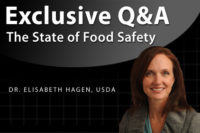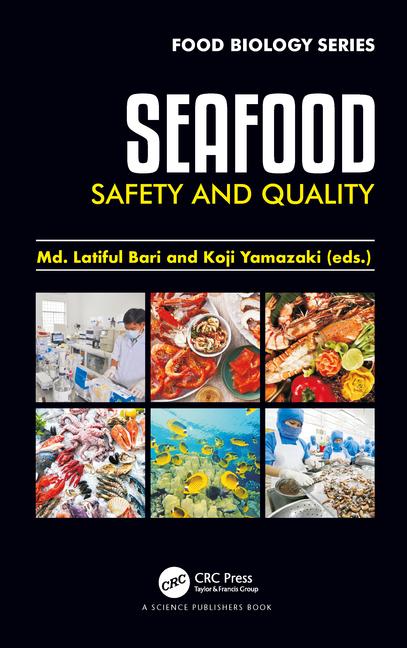Food Safety Q&A with Dr. David Acheson, FDA
Andy Hanacek, The National Provisioner: Can you shed some light onto the thought process that went into the creation of your role with the FDA?
Dr. David Acheson: I am the Assistant Commissioner for Food Protection at the Food & Drug Administration (FDA), which is a position that was created at the beginning of May to do a number of things, including to develop a trans-agency, strategic plan to address food and feed safety and defense. … Strategically what I’m doing is looking at this from a risk-based perspective of what we need to do to define the risks and focus resources in the areas we see those risks. One of the big shifts that I’m focused on is moving the agency strategically more in the direction of trying to prevent the problems in the first place rather than trying to react to them. We’re very good at reacting, but what we’d really like to do is focus on prevention.
Hanacek: In your opinion, where would you say the food processing industry as a whole stands in terms of food protection?
Acheson: We have a very safe food supply, and we’re becoming better and better at finding the problems and creating the links between human illness and a particular product, and then following up on it. The detective work is getting better at the state, local and federal [levels]. Having said that, we still have problems and things falling through the cracks.
Hanacek: Overall, media coverage of illnesses and outbreaks seems to be very aggressive and very on-the-ball with these events. Do you think that indicates simply increased awareness, or is it indicative of the “problems and things falling through the cracks,” as you say?
Acheson: If you look statistically at the total number of illnesses and outbreaks, it really hasn’t changed much. … [E. coli in] spinach was really the situation that kicked the media interest off, and there has been continued media attention to food-safety issues since then. I think that’s a good thing, because it focuses public attention on something that would be nice to do better. I don’t want to convey that we have serious problems or the system’s falling apart — it isn’t; we have a very robust system.
To bring it to the personal level: There are approximately 300 million Americans living in the United States, each consuming food usually three times a day, multiple different types of foods and locations, and the relative lack of serious foodborne illness, considering the billions of servings of food consumed on an annual basis, is really pretty amazing. We are doing pretty well, but our job is to make ‘pretty well’ even better. Another important message is, when you’re dealing with food grown in the dirt and not cooked, it’s impossible to guarantee 100 percent safety — you couldn’t do it unless you put some sort of intervention step in place. With certain food commodities like fresh produce that you don’t want to cook, … turning it to zero risk is next to impossible. So the goal is to push risk as low as you possibly can.
Hanacek: How can the government improve regulation of food safety and food defense and get the industry to do a lot better in pushing the risk as low as possible?
Acheson: Like I said, I think the emphasis needs to shift from reaction to prevention. … The industry is in position to be able to prevent the problems — they have their hands on the food being grown, manufactured and distributed, and thus they have a vested interest in maintaining a safe, secure food supply. In my conversations with industry, they understand that and are more than willing to step up to the plate to try to prevent problems in the first place. I think they’re looking to the federal government to provide them with advice and guidance on what’s the optimal way to protect the food supply. In some instances, we have a pretty good idea on how to do that, and in others, we need more research and science to understand it.
Case in point, everyone wants to prevent spinach and lettuce from being contaminated with E. coli, but what do you really need to do to have that? An understanding of how the bugs get onto the spinach in the first place is needed — that’s sort of the science component. That would be where we would try to put our emphasis, on prevention and understanding where the risks are, and driving the whole strategy based on risk. You simply cannot test everything or inspect everything; it’s just not realistic or cost-effective to do that. So you need to put your energies where the risks are.
Hanacek: The House Agriculture Committee recently voted for country-of-origin labeling on all meat products starting next year. Although FDA does not regulate meat, in light of the current media frenzy surrounding imported goods from China, do you think the nation’s overall food supply would benefit to such a strategy?
Acheson: There is a lot of pressure to use country-of-origin labeling on food products, and it actually is already on some things — seafood, for example, has to have country-of-origin labeling, even though USDA regulates the labeling aspect of it. As you point out, there are moves to do it to more products. My perspective on it is, simply knowing the country in which a product is manufactured or grown is no guarantee that it is safe. … Right now, obviously, China is in the sights — so if it’s made in China, [a consumer says,] ‘I don’t want to eat it because it will make me sick, but if it’s made in the U.S. I’m going to be fine.’
But there is no science to back that claim up. My concern here, purely from a public-health, food-safety perspective, is that we need to make sure country-of-origin labeling does not generate a false sense of security. In and of itself, it is not a stamp of safety. It is simply a piece of information that a consumer can know, much like sodium or fat content.
Plus, it gets really complex when you’re dealing with a finished product that has multiple ingredients, because the global food supply is such that many of those ingredients could come from multiple different countries, and how would a consumer deal with that?
If it’s a whole piece of meat or a whole fish, it’s not so difficult.
But if it is a hamburger with 50 different components in it, with the bread, lettuce, tomatoes, sauce, pepper, salt, etc. you could end up with a list of 30 or 40 countries.
Hanacek: In extreme cases, the country-of-origin list could be longer than the ingredients list then.
Acheson: Absolutely, absolutely. And it would change too, because you may get your lettuce from the United States in the summer, but from Mexico in the winter. So it’s dramatically complex, and the danger is that consumers will just throw up their hands and say, ‘I can’t even understand this — this isn’t helping me.’
Fundamentally, it’s important to not think of country-of-origin labeling as any assurance of safety. We need to treat food safety as a separate issue, whether it be domestic or foreign foods — it’s a standalone issue that needs to be at its maximum.




Report Abusive Comment